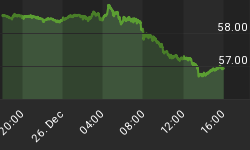The S&P 500 index is at a key support line, while futures funds are again massively short the European currency. More selling is possible, but the decline appears to be limited. Crude oil prices will fall more?
The U.S. economy is pausing again.
Like last year, the European struggle is weighing on growth. Durable good order increased only 0.2% in April after having declined 3.7% in March. Non-defense capital goods fell instead for the second straight month. They slumped 1.9% in April and 2.2% in March. Declining exports, especially to the euro zone, might have played a role in recent data. Weakness could persist over the short-term. However, the U.S. economy has the capacity to overcome the challenge. As we have written for months, the housing market is finally bottoming. Home sales are increasing, inventories are shrinking and prices are stabilizing in most regions. If history repeats itself, the recovery to new highs will take between 3/5 years from the bottom (2009/10). Nevertheless, consumer delinquency is declining and mortgage default is fading. Confidence should increase, along with a recovery of the housing market. An upgrade of credit quality will give banks the opportunity to loosen credit standards.
Are we out of the slumps yet? No, we are not. The almost $ 700 billion household debt reduction since 2008 is the classical light at the end of the tunnel. Nonetheless, the recovery stays fragile and deep contractions are still possible. The economy is only growing around 2.0%. The unemployment rate should correct to 8.0%-7.8% over the coming months. However, the study of cycles anticipates unemployment to test the highs again for its final third wave. In the mean time, the U.S. debt is huge. Finally, the current account deficit has increased. Nevertheless, financing from China and Japan is drying up. As a result, the possibility of another quant easing in the U.S. is a real possibility. It should limit the rise of the U.S. dollar and probably support stocks. The S&P 500 index is meeting a good support line at 1280. It corresponds to 200 days MA line. The next level to watch is at 1240.

Volatility will remain high
Markets should remain volatile until mid-June, when Greece will have new political elections. At that time, it should be clear, if the majority of the population wants to remain within the euro zone or play solo. The financial community does not want Greece to leave the Union. Financial losses would be substantial for the European banks. The Greek financial system will probably collapse. Finally, it would create a precedent for others to follow. The E.C.B might ease some of the conditions of the recent bailout. Will it be enough? In Greece, the political and economical struggle should continue for the years to come. What will happen to the euro zone is yet to be seen, but the European currency has the capacity to surprise investors once more. Eur/usd has reached an important support line at 1.26/1.25. A move below 1.2370 is necessary for a decline to 1.20. It would correspond to the lower channel-line. Nevertheless, according the latest COT report, futures funds are again massively short the European currency. It could be the prelude of important turning points for the European currency. It happened January 2012 and May 2011.

Austerity is clearly not enough. Confidence fell drastically lately. The preliminary PMI for activity, which anticipates G.D.P. trends, fell to the lowest level since June 2009. New orders are plunging, eventually forecasting new losses ahead. As a result, the Gross Domestic Product should contract in the second part of the year. The European Central Bank (E.C.B.) could intervene again with one of the manoeuvres used in the past two years, including cutting the interest rates. Eurobonds is a possible solution. Funds would be moved away from Germany and spread over the whole euro zone. Banks stability should improve. Yields on peripheral countries might then decline. For now, Germany is against Eurobond issuing. Why? German yields would move higher. The country reputation would be at stake. Some nations will use Eurobonds as an excuse to avoid pursuing the reforms. However, the majority of the European nations consider it a valid option. It will be the first step toward a greater financial integration. The positive factor is inflation softening. The trend should persist for few more weeks/months. In fact, futures funds are heavily long the crude oil market. Positions must be first reduced for oil prices to rise again.
















